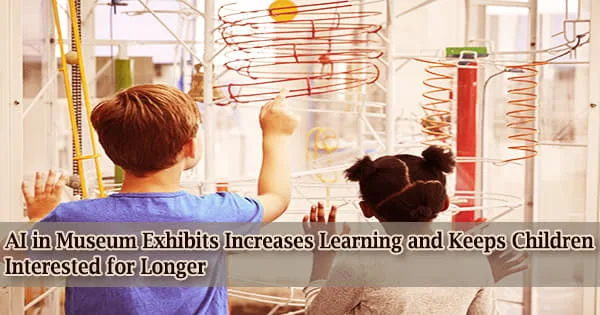Children adore hands-on exhibits, which are a mainstay of science and children’s museums all around the world. Children are encouraged to study scientific ideas in the exhibitions in a fun and engaging way.
But do kids really absorb anything from them?
To help children navigate the exhibits and promote learning, it is ideal to have museum employees, parents, or other caregivers present. However, this is not always feasible.
The Human-Computer Interaction Institute (HCII) at Carnegie Mellon University has found a more efficient technique to promote learning and boost engagement.
Incorporating an intelligent virtual assistant to engage visitors, they used artificial intelligence to pioneer a new category of interactive, hands-on displays. The intelligent exhibit enhanced learning and time spent at the exhibit, according to the researchers’ comparison of it to a conventional one.
“Having artificial intelligence and computer vision turned the play into learning,” said Nesra Yannier, HCII faculty member and head of the project, who called the results “purposeful play.”
Exhibits with earthquake tables are well-liked. Kids build towers and then watch them fall on a moving table in a classic illustration. It is unclear how well or how frequently the signs around the display are read. The signs aim to get kids to think about science while they play.
The AI-enhanced seismic table that Yannier oversaw was constructed with a camera, touchscreen, huge display, and an intelligent agent named NoRilla to replace the signs. NoRilla, a virtual gorilla, engages users by leading them through various difficulties, posing questions on why towers fell or didn’t, and assisting them in coming to scientific conclusions.
At the Carnegie Science Center in Pittsburgh, the team Yannier, Ken Koedinger, and Scott Hudson from CMU, Kevin Crowley from the University of Pittsburgh, and Youngwook Do from the Georgia Institute of Technology tested their intelligent earthquake exhibit.
Our exhibit automated the guidance and support that make hands-on physical experimentation a valuable learning experience. In museums, parents may not have the relevant knowledge to help their children, and staff may not always be available. Using AI and computer vision, we can offer this experience to more children of different backgrounds and at a wider scale.
Nesra Yannier
Pre- and post-tests, surveys, and interactions with either the conventional or intelligent exhibit were all performed by elementary-aged campers to determine what they had learned and how much they had enjoyed the experiment. During regular hours, researchers also saw people interacting with the exhibit.
Children learnt considerably more from the AI-enhanced intelligent science exhibit than they did from the conventional exhibit while still having a great time, according to pre and post-tests and questionnaires.
Unexpectedly, the results showed that even while children built more in the typical exhibit, their construction abilities did not advance at all since they mostly focused on random tweaking rather than comprehending the fundamental ideas.
The AI-enhanced exhibit improved children’s understanding of the underlying scientific ideas as well as their building and engineering skills. Their study at the Science Center also revealed that visitors to the intelligent display spent roughly six minutes there, which is four times longer than the 90-second average for the conventional one.
“What’s particularly impressive to me is how the system engages kids in doing real scientific experimentation and thinking,” said Koedinger, a professor in HCII, “The kids not only get it, they also have more fun than with usual exhibits even though more thinking is required.”
The display, in comparison to other exhibitions, was more interactive, guided, and educational, according to the parents of children who visited it. They added that while it uses play-based learning as well as inquiry learning, which is the foundation of how children learn, it doesn’t appear to be a learning activity.
“Our exhibit automated the guidance and support that make hands-on physical experimentation a valuable learning experience,” Yannier said. “In museums, parents may not have the relevant knowledge to help their children, and staff may not always be available. Using AI and computer vision, we can offer this experience to more children of different backgrounds and at a wider scale.”
The team’s investigation got underway at the Children’s Museum of Pittsburgh, where they evaluated the layout of their intelligent exhibit and made adjustments in response to user feedback.
“This research will have lasting implications for future exhibit experiences at the Science Center,” said Jason Brown, the Henry Buhl Jr. director of the Carnegie Science Center. “Creating hands-on fun and inspirational exhibit experiences that scaffold science, technology, engineering or mathematics learning, and discovery is what positions us as one of the most unique museums in the region.”
The group’s research was just recently published in the Journal of the Learning Sciences. The clever science exhibit is still on display at the Carnegie Science Center. The Children’s Discovery Museum of San Jose, California, and the Please Touch Museum in Philadelphia will soon both host it. It is also on display at the Children’s Museum of Atlanta.
“The Children’s Museum of Atlanta is enjoying being a part of this research study. As we have observed the NoRilla in action, we see high levels of ‘stay time’ for children and adults as they work to meet the challenges through the combination of hands-on activities with computer-based challenges,” said Karen Kelly, the director of exhibits and education at the Atlanta museum.
“We love that this experience aligns with our mission of sparking every child’s imagination, sense of discovery, and learning through the power of play.”
The CMU team is already hard at work developing further intelligent science exhibitions that educate various scientific concepts using computer vision and AI. An installation with ramps and one with a balance scale are upcoming initiatives.
Yannier emphasized that this technology might help children study in a classroom or at home as well as in a museum, enhancing both learning environments.
















